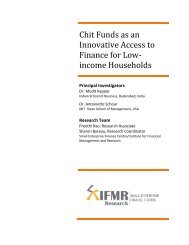Government of India Volume I: Analysis and Recommendations
Government of India Volume I: Analysis and Recommendations
Government of India Volume I: Analysis and Recommendations
Create successful ePaper yourself
Turn your PDF publications into a flip-book with our unique Google optimized e-Paper software.
MICRO-PRUDENTIAL REGULATION<br />
Table <strong>of</strong> <strong>Recommendations</strong> 6.9 Principles <strong>of</strong> micro-prudential regulation<br />
The regulator must consider the following principles in discharging its functions <strong>and</strong> exercising its powers:<br />
1. Any obligation imposed on regulated persons should be proportionate to-<br />
◮ the nature, scale <strong>and</strong> complexity <strong>of</strong> the risks in the regulated activity being carried out; <strong>and</strong><br />
◮ the manner in which the regulated activity ranks on the factors stated in Table 6.2<br />
2. Regulatory approach needs to take into account the feasibility <strong>of</strong> implementation by regulated persons <strong>and</strong><br />
supervision by the Regulator;<br />
3. The need to minimise inconsistencies in the regulatory approach towards regulated activities that are similar<br />
in nature or pose similar risks to the fulfilment <strong>of</strong> the Regulator’s objectives under this Act;<br />
4. Any obligation imposed on regulated persons should be consistent with the benefits, considered in general<br />
terms, which are expected to result from the imposition <strong>of</strong> that obligation;<br />
5. The desirability <strong>of</strong> facilitating competition in the markets for financial products <strong>and</strong> financial services <strong>and</strong><br />
minimising the adverse effects <strong>of</strong> regulatory actions on competition in the financial sector;<br />
6. The desirability <strong>of</strong> facilitating access to financial products <strong>and</strong> financial services;<br />
7. The desirability <strong>of</strong> facilitating innovation in financial products <strong>and</strong> financial services;<br />
8. The need to ensure that regulatory actions are carried out in a manner that is least detrimental to competitiveness<br />
<strong>of</strong> <strong>India</strong>’s financial system;<br />
9. The need to take into account the long-term implications <strong>of</strong> regulatory actions, which will include a period<br />
<strong>of</strong> at least five years following a regulatory action;<br />
10. The need to minimise the pro-cyclical effects <strong>of</strong> regulatory actions; <strong>and</strong><br />
11. The requirement that persons who control <strong>and</strong> manage the affairs <strong>of</strong> regulated persons must share the responsibility<br />
<strong>of</strong> ensuring the safety <strong>and</strong> soundness <strong>of</strong> the regulated persons.<br />
◮ the nature, scale <strong>and</strong> complexity <strong>of</strong> the risks in the regulated activity being carried<br />
out; <strong>and</strong><br />
◮ the manner in which the regulated activity ranks on the factors stated in Table 6.2<br />
This principle requires that regulatory instruments are used in a manner that is risk<br />
sensitive; the intensity <strong>of</strong> regulation should be proportional to risk held by the regulated<br />
person. For example, compare two banks with the same balance sheet size. One <strong>of</strong> them<br />
is investing only in low risk assets, while the other is investing in high risk assets. A regulatory<br />
approach that is sensitive to the risks will impose different micro-prudential requirements<br />
on these two regulated persons, because they have different levels <strong>of</strong> risks to<br />
their safety <strong>and</strong> soundness. Similarly, the factors listed in Table 6.2 translate the market<br />
failures providing the rationale for micro-prudential regulation into tangible tests. These<br />
tests can be used not just to determine where micro-prudential regulation will apply, but<br />
also to decide the extent to which such regulation are to be applied. Regulation ought to<br />
be proportional to the risks <strong>and</strong> market failures.<br />
PRINCIPLE 2. Regulatory approach needs to take into account the feasibility <strong>of</strong> implementation<br />
by regulated persons <strong>and</strong> supervision by the Regulator.<br />
The Commission notes that the regulatory approach should be modulated in light <strong>of</strong><br />
questions <strong>of</strong> feasibility for regulated entities <strong>and</strong> the capacity <strong>of</strong> regulators to supervise.<br />
For example, consider buffers to absorb losses. Risk-weighted capital based on internal<br />
models is potentially the most sensitive to risk though also the most opaque from<br />
the perspective <strong>of</strong> regulatory supervision. Simple leverage ratios are likely to be the least<br />
risk sensitive though easiest for regulators to monitor <strong>and</strong> enforce. While laws should<br />
not be constructed for regulatory convenience, the possibility <strong>of</strong> frustration <strong>of</strong> regulatory<br />
objectives should be kept in mind.<br />
Alternatively, consider institutional capability, including questions <strong>of</strong> regulated persons<br />
manipulating regulatory frameworks to their advantage. A regulated person using<br />
the right internal models, <strong>and</strong> having access to sufficient data, could achieve fairly risk<br />
sensitive capital buffers. Conversely, a regulated person using poor models or insufficient<br />
data could fail to do so. Opacity raises the possibility <strong>of</strong> manipulation though regulation<br />
FINANCIAL SECTOR LEGISLATIVE REFORMS COMMISSION 63



